Intel Z68 Chipset & Smart Response Technology (SSD Caching) Review
by Anand Lal Shimpi on May 11, 2011 2:34 AM EST
Intel's SSD 311 20GB: Designed to Cache
Although SRT supports any SSD, Intel created a brand new drive specifically for use as a cache with Z68 platforms. This is the Intel SSD 311, codenamed Larson Creek:
The SSD 311 uses the same controller as Intel's X25-M G2, SSD 310 and SSD 320 drives:
The big difference here is the SSD 311 comes with 20GB of 34nm SLC NAND. If you remember back to the SSD Anthology, SLC NAND is architecturally identical to MLC NAND. With half the number of data stored per NAND cell SLC NAND not only lasts longer than MLC NAND but it also is much faster, particularly for writes.
As a cache that'll be constantly written to, SLC NAND isn't a bad decision on Intel's part. Intel insists that the move wasn't motivated by reliability but rather write performance.
A quick look at the performance of the SSD 311 shows that it packs a lot of punch for being a small 20GB drive with only 5 of 10 NAND channels populated:
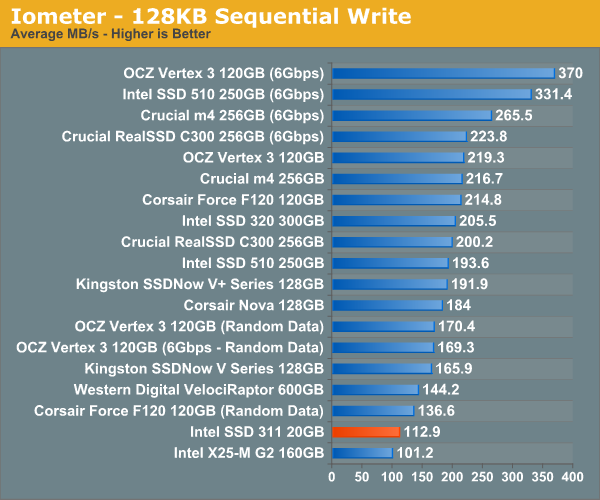
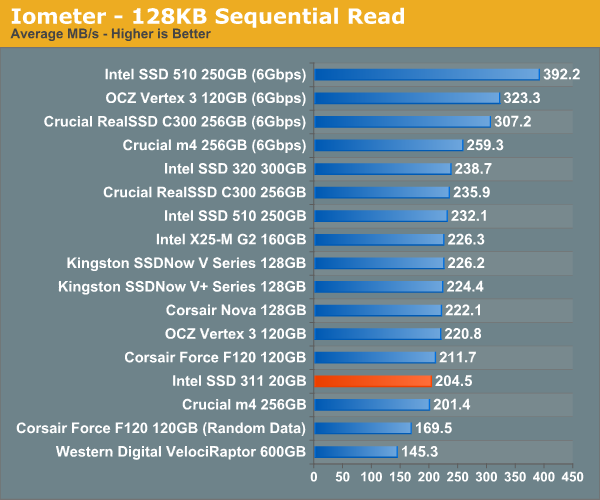
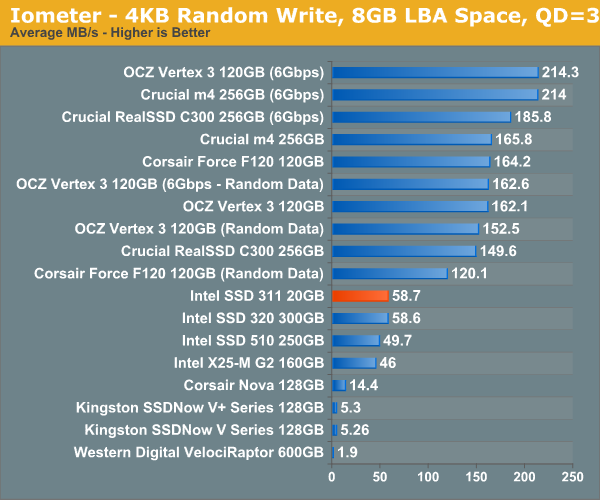
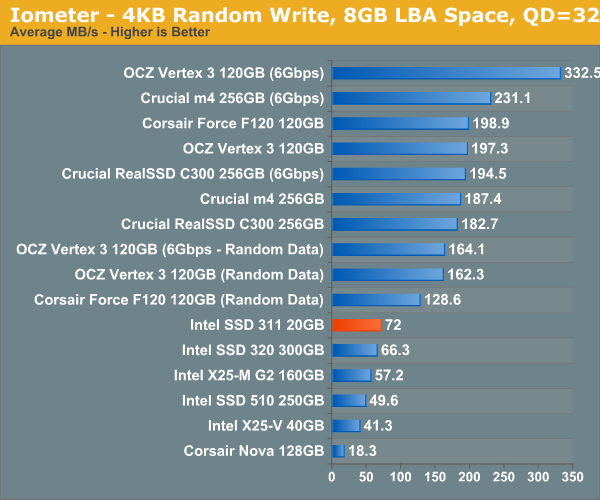
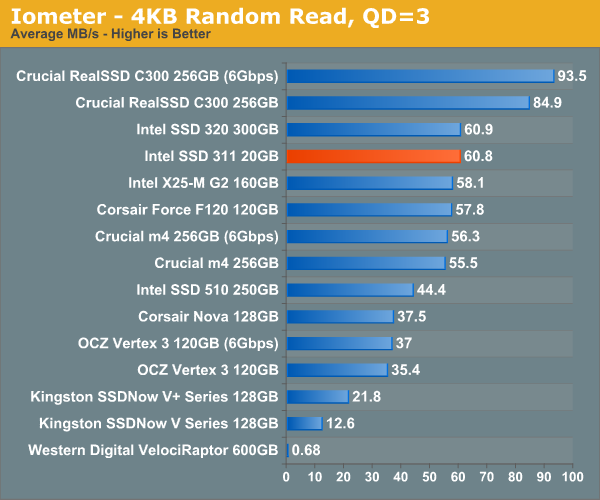
The SSD 311 basically offers the performance of a 160GB X25-M G2 but with fewer NAND channels and a much lower capacity.
Remember this is SLC NAND so despite only being a 20GB drive, it's priced more like a 40GB MLC drive: Intel expects the SSD 311 to retail for $110. Thankfully you aren't locked in to only using Intel drives as Smart Response Technology will work with any SSD.




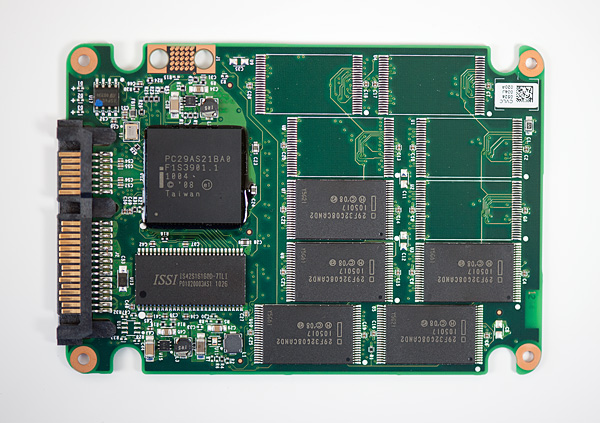
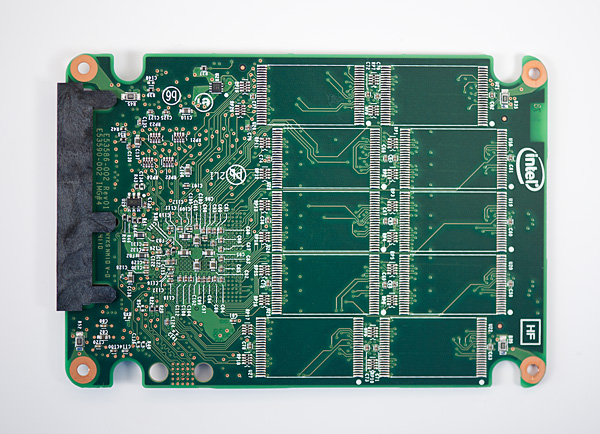








106 Comments
View All Comments
davidgamer - Wednesday, May 11, 2011 - link
I was wondering if it would still be possible to do a RAID set up with SRT? For example I would probably want to do a RAID 5 set up with 3 3TB drives but also have the cache enabled, not sure if this would work though.hjacobson - Thursday, May 12, 2011 - link
RE: Z68 capable of managing SRT and traditional RAID at the same time?I've looked for an answer to this without success.
I did find out the H67 express chipset can't manage more than one RAID array. I won't be surprised to learn the same for the Z68. Which is to say, your choice: either SRT or traditional RAID, but not both.
Sigh.
jjj - Thursday, May 12, 2011 - link
" I view SRT as more of a good start to a great technology. Now it's just a matter of getting it everywhere."It actually doesn't have much of a future,so ok Marvell first made it's own chip that does this,now Intel put similar tech on Z68 but lets look at what's ahead.As you said NAND prices are coming down and soon enough SSDs will start to get into the mainstream eroding the available market for SRT while at the same time HDD makers will also have much better hybrid drives.All in all SRT is a few years late.
HexiumVII - Thursday, May 12, 2011 - link
What happens if we have an SSD as a boot drive? Would it recognize it as an SSD and only cache the secondary HDD? It would be nice to have that as my boot SSD is only 80GB and my less frequent used progs are in my 2teras. This is also great for upgraders as now you have a use for your last gen SSD drives!Bytown - Thursday, May 12, 2011 - link
A feature of the Z68 is that any SSD can be used, up to 64GB in size. Anandtech does the best SSD reviews I've read, and I was dissapointed to not see some tests with a larger cache drive, especially when there were issues with bumping data off of the 20GB drive.I think that a larger cache drive will be the real life situation for a majority of users. There are some nice deals on 30GB to 64GB drives right now and it would be great to see a review that tries to pinpoint the sweet spot in cache drive size.
irsmurf - Thursday, May 12, 2011 - link
Hopefully my next workstation will have SSD for cache and an HDD for applications storage. This will greatly shorten length of time required to transition to SSD in the workplace. A one drive letter solution is just what was needed for mass adoptation.Its like a supercharger for your hard drive.
GullLars - Thursday, May 12, 2011 - link
This seems like a good usage for old "obsolete" SSDs that you wouldn't use as a boot drive any more. I have a couple of 32GB Mtrons laying around, and while their random write sucks (on par with velociraptor sustained, but not burst) the random read at low QDs is good (10K at QD 1 = 40MB/s). I've been using them as boot drives in older machines running dual cores, but it could be nice to upgrade and use them as cache drives instead.It would be nice to see a lineup of different older low-capacity SSDs (16-64GB) with the same HDDs used here, for a comparison and to see if there's any point in putting a OCZ Core, Core V2, Apex, Vertex (Barefoot), Trancend TS, Mtron Mobi/Pro, Kingston V+, or WD Silicon Drive for caching duty.
Hrel - Thursday, May 12, 2011 - link
I'd like to see if using something like a Vertex 3 at 64GB would make much difference compared to using Intels 20GB SSD. Seems like it should evict almost never; so I'd expect some pretty hefty reliability improvements.marraco - Thursday, May 12, 2011 - link
Is only matter of time until SSD caching is cracked and enabled on any motherboard.ruzveh - Thursday, May 19, 2011 - link
Not so impressive as i would like it to be.